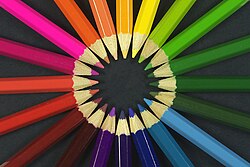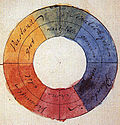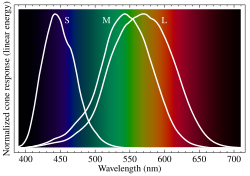The opponent process is a color theory that states that the human visual system interprets information about color by processing signals from photoreceptor...
30 KB (3,506 words) - 03:11, 18 April 2025
Opponent-process theory is a psychological and neurological model that accounts for a wide range of behaviors, including color vision. This model was first...
15 KB (1,954 words) - 14:42, 8 June 2025
Unique hues (section Opponent process theory)
purest hues of blue, green, yellow and red. The proponents of the opponent process theory believe that these hues cannot be described as a mixture of...
17 KB (2,092 words) - 18:48, 28 April 2025
Color wheel (section Opponent process model)
are named keywords in HTML. Some color wheels are based on the four opponent process colors - red, yellow, blue and green. This includes those of the Natural...
18 KB (2,154 words) - 01:30, 5 June 2025
Impossible color (section Opponent process)
otherwise. The color opponent process is a color theory that states that the human visual system interprets information about color by processing signals from...
25 KB (3,085 words) - 04:04, 13 June 2025
Visual perception (redirect from Visual processing in the brain)
the green cone would inhibit the red/green ganglion cell. This is an opponent process. If the rate of firing of a red/green ganglion cell is increased, the...
37 KB (4,407 words) - 22:42, 19 June 2025
complementary color pairs are red–green, yellow–purple, and blue–orange. Opponent process theory suggests that the most contrasting color pairs are red–green...
25 KB (3,315 words) - 21:01, 19 June 2025
Shades of blue (redirect from Process blue)
primary colors red, yellow, green, and blue. The NCS is based on the opponent process theory of vision. The "Natural Color System" is widely used in Scandinavia...
64 KB (5,631 words) - 00:11, 26 May 2025
Color vision (category Image processing)
criticism of the opponent process theory, stemming from a number of what are presented as discrepancies in the standard opponent process theory. For example...
65 KB (7,923 words) - 06:16, 19 June 2025
Pain and pleasure (section Opponent process theory)
perspectives to why a relationship could be evolutionarily advantageous. The opponent-process theory is a model that views two components as being pairs that are...
28 KB (3,355 words) - 19:24, 25 May 2025
spatiotemporal frequency components. Research indicates that the blue–yellow opponent process accounts for all the different PIFCs. Research has been done into the...
5 KB (604 words) - 22:41, 17 June 2025
the opponent process theory, humans have three opponent channels, which give trichromacy. It is unclear whether having available a fourth opponent channel...
26 KB (2,781 words) - 21:46, 22 May 2025
an opponent-process theory such as that articulated by Ewald Hering (1878) and further developed by Hurvich and Jameson (1957). The opponent process theory...
10 KB (1,284 words) - 19:20, 31 May 2025
to describe colors appear under different viewing conditions. The opponent process was proposed by Ewald Hering in which he described the four unique...
85 KB (9,897 words) - 20:41, 6 June 2025
Illusion of control Induced demand Leisure satisfaction Lifestyle creep Opponent-process theory Positive psychology Positivity offset Satisfaction paradox Say's...
34 KB (4,097 words) - 02:36, 21 June 2025
Dual process model of coping Dual process theory (moral psychology) – Theory of human moral judgment Opponent-process theory – Psychological and neurological...
58 KB (7,288 words) - 22:22, 2 June 2025
primary colors red, yellow, green, and blue. The NCS is based on the opponent process theory of vision. The “Natural Color System” is widely used in Scandinavia...
21 KB (1,579 words) - 21:33, 11 June 2025
Habituation (section Dual-process theory)
pattern coincides with two internal processes referred to as the a-process and b-process. Hence, the opponent-process theory predicts that subjects will...
42 KB (5,535 words) - 05:24, 9 June 2025
primary colors red, yellow, green, and blue. The NCS is based on the opponent process theory of vision. The Natural Color System is widely used in Scandinavia...
40 KB (3,730 words) - 13:59, 9 June 2025
u*, v*) and (L*, a*, b*), respectively—are cartesian, based on the opponent process theory of color, but both are also often described using polar coordinates—(L*...
35 KB (4,071 words) - 21:50, 19 June 2025
primary colors red, yellow, green, and blue. The NCS is based on the opponent process theory of vision. The Natural Color System is widely used in Scandinavia...
58 KB (5,745 words) - 07:45, 10 June 2025
would otherwise have to be larger to deal with the complex task of opponent process colour perception used by other species, thus requiring more time and...
57 KB (5,959 words) - 01:33, 18 June 2025
It is based on the opponent model of human vision, where red and green form an opponent pair and blue and yellow form an opponent pair. This makes CIELAB...
22 KB (2,883 words) - 06:09, 27 April 2025
Color (category Image processing)
Ewald Hering developed the opponent process theory of color, noting that color blindness and afterimages typically come in opponent pairs (red-green, blue-orange...
59 KB (7,037 words) - 08:59, 17 June 2025
sophisticated models of color space and color perception, such as the opponent process theory. Across the same period, industrial chemistry radically expanded...
32 KB (4,262 words) - 14:52, 26 May 2025
with temperature. Paul Churchland using the Hurvich–Jameson (H–J) opponent process criticizes the inverted spectrum on scientific grounds: If the Hurvich–Jameson...
9 KB (1,150 words) - 06:24, 8 June 2025
Frequency response (category Signal processing)
behaviors with opponent process dynamics, or in the optimization of drug treatment regimens. Audio system measurements Bandwidth (signal processing) Bode plot...
11 KB (1,282 words) - 21:39, 7 May 2025
allows the brain to perceive a continuous range of colors through the opponent process of color vision. Rod cells have a peak sensitivity at 498 nm, roughly...
17 KB (1,893 words) - 14:53, 16 April 2025
primary colors red, yellow, green, and blue. The NCS is based on the opponent process theory of vision. The Natural Color System is widely used in Scandinavia...
43 KB (4,314 words) - 01:51, 11 April 2025


















